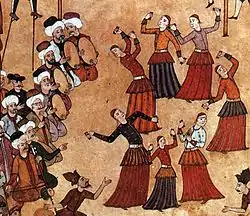Kaşık Havası
Kaşık Havası (tr), Kaşık Oyunları (tr), Χορός κουταλιών (el) (Turkish and Greek, meaning 'spoon rhythm' and 'spoon dances', respectively, owing to the use of pairs of wooden spoons as a musical instrument) are Turkish folk dances mostly spread over the Mediterranean region and have a varying structure of their arrangement, performance, rhythmic and melodic characteristics.[1][2] They are always rendered with wooden spoons and the characteristic measure is 2
4 or 4
4. The instruments used are beast bow (later violin), baglama and clarinet, in general, they are accompanied by folk songs.[3]

"Köçek troupe at a fair" at Sultan Ahmed's 1720 celebration of his son's circumcision. Miniature from the Surname-i Vehbi, Topkapı Palace, Istanbul.
References
- "14_Turkish Spoon Dance - International Office | Hong Kong Baptist University". intl.hkbu.edu.hk. Retrieved 2022-03-03.
- "KASIK HAVASI DANCE - TURKEY". Dance Ask. 2017-12-17. Retrieved 2022-03-03.
- Seeman, Sonia Tamar (2019-06-12). Sounding Roman: Representation and Performing Identity in Western Turkey. Oxford University Press. ISBN 978-0-19-994925-0.
| External video | |
|---|---|
This article is issued from Wikipedia. The text is licensed under Creative Commons - Attribution - Sharealike. Additional terms may apply for the media files.